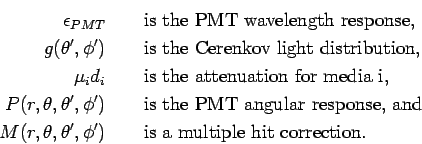![\begin{displaymath}
N_{eff} = [\mbox{NHITs} - N_{dark}] \times \frac{1}{\epsilon_{response}} \times \frac{1}{\epsilon_{hardware}}
\end{displaymath}](img305.png) |
(19.1) |
To determine the energy of an event in the SNO detector, we must apply corrections for the optical response of the detector to a given event, as well as corrections for the current state of the detector hardware. Events are reconstructed to determine the event's vertex and direction. This section describes the RSP processor which assigns an event energy by taking these factors into account. A more complete study of energy calibration with the RSP processor will follow in an STR.
For the energy calibration, we define an effective number of PMTs hit as
![\begin{displaymath}
N_{eff} = [\mbox{NHITs} - N_{dark}] \times \frac{1}{\epsilon_{response}} \times \frac{1}{\epsilon_{hardware}}
\end{displaymath}](img305.png) |
(19.1) |
with
| (19.3) |
| (19.4) | |||
| (19.5) | |||
| (19.6) |
| (19.7) |
where

![]() is an optical correction factor which accounts for attenuation of photons in the detector media, the photo-multiplier tube response and multiple hits in a single PMT.
is an optical correction factor which accounts for attenuation of photons in the detector media, the photo-multiplier tube response and multiple hits in a single PMT.
![]() is applied to scale the number of PMTs available for the current event to the number in the Monte-Carlo.
is applied to scale the number of PMTs available for the current event to the number in the Monte-Carlo.
We can then determine the event energy via
| (19.8) |
with